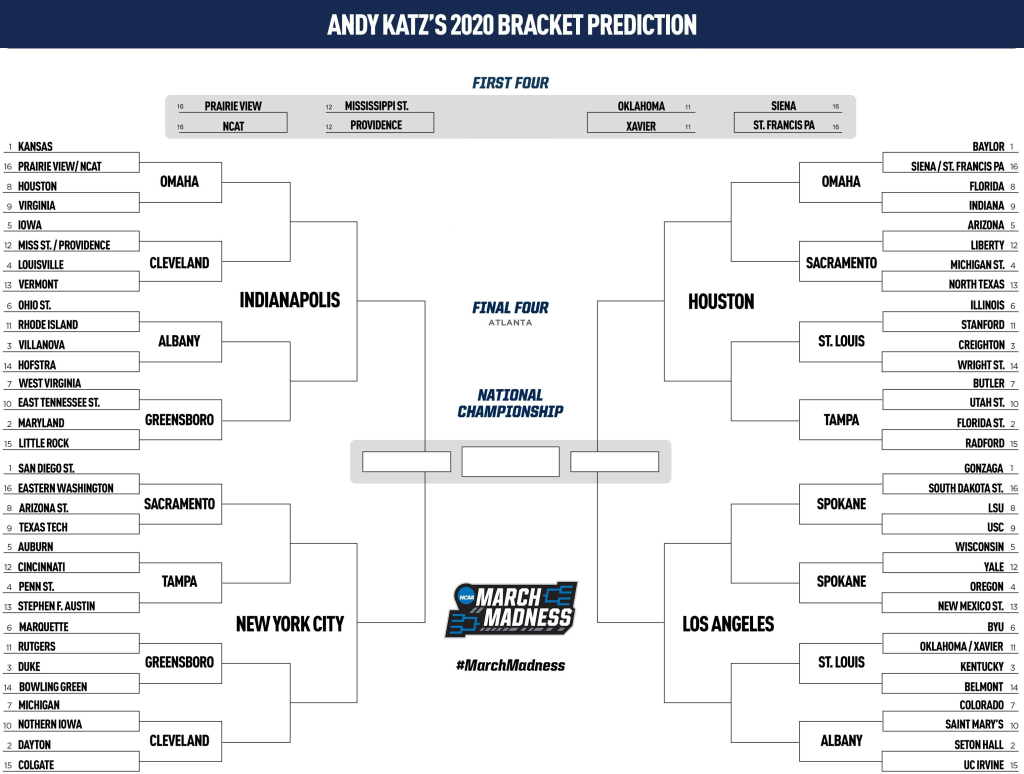
When it comes to NCAA bracket prediction, the excitement of March Madness captivates millions across the nation. Statistically, achieving a perfect NCAA bracket is considered one of the most challenging feats in sports, making it a topic of fascination for fans and analysts alike. With the NCAA bracket odds stacked heavily against participants, understanding winning NCAA bracket strategies becomes essential for those looking to make accurate March Madness predictions. As upsets inevitably unfold throughout the tournament, conducting a thorough statistical analysis of NCAA brackets can enhance your chances of standing out in the competition. Join us as we delve deeper into the art and science of predicting outcomes during this thrilling season of college basketball.
The phenomenon of predicting outcomes in college basketball tournaments, often referred to as NCAA bracket forecasting, draws attention from sports enthusiasts and casual fans alike. With each game, the stakes rise, and enthusiasm for the challenge of creating a flawless tournament path intensifies. Many strive for the elusive perfect tournament predictions, yet most face daunting odds that stem from the unpredictability of matchups and upsets. This quest to navigate the chaos of the March Madness landscape requires not only passion but also strategic thinking, making the exploration of effective techniques to win bracket pools a must. In this discussion, we will explore the fundamentals of successful bracket forecasting and uncover insights that can potentially increase your chances of victory.
Understanding NCAA Bracket Predictions
NCAA bracket predictions are an integral part of the March Madness experience. Each year, millions of fans take to filling out their brackets, trying to forecast the outcomes of the 64-team tournament. The challenge lies not just in picking the winning teams but also in anticipating upsets that can derail the favorites. As a fan looking to make solid predictions, understanding NCAA bracket odds is crucial. Statistically analyzing past tournaments, identifying high seed trends, and evaluating team performance can significantly increase your prediction accuracy.
Moreover, statistical analysis of NCAA brackets often reveals essential patterns that can aid prediction. For instance, historical performance has shown that top seeds generally have a higher probability of advancing, especially in the early rounds. However, by adopting a multi-faceted approach—considering not just the stats, but player conditions, matchups, and even coaching styles—predictors can make more informed decisions when filling out their brackets. The balance between choosing favorites and predicting upsets is what makes these predictions both thrilling and challenging.
The Quest for a Perfect NCAA Bracket
Achieving a perfect NCAA bracket is often likened to winning the lottery. With astronomical odds of 1 in 9.2 quintillion for creating such a bracket, most experts agree that it is highly improbable that anyone will succeed in doing so in their lifetime. The essence of the challenge is inherent in the unpredictable nature of March Madness, with its myriad of upset possibilities. This unpredictability is compounded by the pressure of accurately predicting outcomes for 63 games, where only one team emerges victorious.
Despite these staggering odds, understanding NCAA bracket strategies can elevate your chances of enjoying the tournament experience. While no one can statistically guarantee a perfect bracket, meticulous strategies and solid research can significantly enhance your performance. Learning about the importance of selecting reliable teams and effectively balancing them with calculated risks, such as potential upsets, can make your tournament experience more enjoyable and competitive.
Winning Strategies for Your NCAA Bracket
When it comes to winning NCAA bracket pools, employing effective strategies is key. First and foremost, it’s essential to understand the participants and the nature of the pool you’re entering. In larger pools, simply choosing the favorites might not be enough to secure victory, as many will likely make similar choices. Thus, factors like identifying strategic upsets can differentiate your bracket from the competition. This requires an analysis of team matchups, as well as considering individual players’ forms and team dynamics throughout the season.
Another element of winning NCAA bracket strategies involves leveraging statistical analysis. Pay attention to trends such as defensive and offensive ratings, historical performance against similar opponents, and injuries. These insights allow for more informed decisions when selecting teams, especially in rounds where upsets are prevalent. Balancing safe picks with a few strategic risks can improve your likelihood of success while keeping your bracket competitive. Understanding the odds and making educated bets on less favored teams is where the art of bracket crafting truly shines.
The Importance of Statistical Analysis in NCAA Brackets
Statistical analysis plays a fundamental role in NCAA bracket predictions. By delving into metrics such as team efficiency ratings, turnover percentages, and head-to-head performances, you can uncover trends that may not be immediately obvious. Such analyses aid in making data-driven decisions when predicting outcomes, ultimately enhancing the success rate of your March Madness predictions. Additionally, tools that offer insights into NCAA bracket odds can be invaluable resources.
However, relying solely on statistics has its pitfalls. The unpredictable nature of tournament play means that data should be combined with qualitative assessments, such as team morale and experience. The mental toughness of players can significantly impact performance in high-pressure situations, making it necessary to look beyond numbers alone. This holistic approach to understanding basketball dynamics can provide a more rounded perspective, thus leading to better overall predictions.
Strategies to Identify March Madness Upsets
Identifying potential March Madness upsets is a thrilling aspect of filling out your NCAA bracket. Statistically speaking, lower-seeded teams often defeat higher-seeded opponents, so understanding patterns and team dynamics is crucial. Factors such as a team’s recent performance, injuries, and matchup history are vital components to consider. For example, a 10-seed defeating a 7-seed is common, but the likelihood varies based on how both teams have performed leading up to the tournament.
Additionally, analyzing the ‘Cinderella stories’ from previous tournaments can inform your upset predictions. For example, teams that have shown resilience and exceptional teamwork often defy the odds during the tournament. Engaging with expert predictions and analyses while maintaining a critical eye can also offer insights into potential upsets. A balanced approach that combines statistical data and an intuitive understanding of the game will make for a more competitive bracket.
Common Misconceptions About Perfect NCAA Brackets
One common misconception about NCAA brackets is that simply choosing the highest seeds guarantees success. While top seeds are favored to win, upsets are a fundamental part of the tournament’s excitement. The unpredictability of March Madness means that even the most meticulously crafted brackets can be derailed by a single upset. It’s essential for fans to embrace this reality and strategize accordingly instead of relying solely on historical data of higher-seeded teams.
Another misconception is that the creation of a perfect NCAA bracket is merely a matter of luck. While luck does play its part, there is a strategic element that involves research and analysis. Recognizing team strengths and weaknesses, understanding the psychological aspects of tournament play, and even tracking player performances are crucial elements in crafting a competitive bracket. By debunking these misconceptions, fans can enhance their approach to filling out brackets and embrace the thrill of March Madness.
The Role of Advanced Metrics in NCAA Bracket Prediction
Advanced metrics are becoming increasingly popular in sports analysis, including NCAA bracket predictions. Metrics such as player efficiency ratings and advanced statistics provide fans and analysts with deeper insights into team performance. By utilizing these metrics, predictors can make more informed choices, especially when grappling with close matchups where traditional statistics may fall short. Advanced analytics allow for a more comprehensive evaluation of team strengths and weaknesses, enhancing the overall prediction process.
Incorporating these advanced metrics into your NCAA bracket strategy does not eliminate the importance of conventional statistics; rather, it complements them. It creates a more nuanced understanding of each team’s capabilities, ultimately improving the chances of making correct predictions. This blend of analytics with traditional analyses can position fans to be better prepared for the unpredictable nature of March Madness.
Tips for Filling Out Your NCAA Bracket
Filling out your NCAA bracket can be both exhilarating and overwhelming. To increase your chances of success, consider establishing a base of knowledge around key stats and trends. Start by researching team performance, player health, and historical outcomes based on seed placement. Being informed about each team creates a solid foundation for making predictions rooted in factual data rather than mere guesses.
Additionally, it’s wise to manage your risks by balancing safe picks with a few high-reward upsets. While it’s critical to choose reliable favorites, upsets are what truly amplify the stakes during March Madness. Weighing the risk of upset picks against the likelihood of a safe choice can elevate your bracket’s potential. Remember to adapt your strategy based on the size and competitiveness of your pool, as aligning your choices with a unique perspective can set you apart from the crowd.
The Psychological Aspect of March Madness
The psychological aspect of March Madness greatly impacts both players and fans alike. As teams strive to achieve victory in high-stakes games, the pressure can either enhance performance or lead to underachievement. Understanding how the mental state of players affects their performance can be pivotal for making accurate NCAA bracket predictions. It’s vital to consider how well a team can perform under pressure and the potential impact on their overall game strategy.
For fans, the excitement and unpredictability of the tournament can lead to impulsive decisions when filling out their brackets. The enthusiasm surrounding March Madness can cloud judgment, leading to selections based on emotion rather than analytical reasoning. Being aware of this psychological phenomenon is essential for making well-informed choices, and it can help fans restrain their instincts in favor of a more calculated approach to bracket predictions.
Frequently Asked Questions
What are the odds of predicting a perfect NCAA bracket?
The odds of achieving a perfect NCAA bracket are astronomically low, approximately 1 in 2 raised to the power of 63, which is comparable to winning the Powerball multiple times. Given the unpredictability of March Madness predictions, it’s highly unlikely that anyone will complete a perfect NCAA bracket during their lifetime.
How can I improve my NCAA bracket predictions?
To enhance your NCAA bracket predictions, consider statistical analysis of NCAA brackets, including team performance, player statistics, and historical data. Using tools that evaluate NCAA bracket odds can help identify potential upsets and improve your chances of success.
What strategies are effective for creating a winning NCAA bracket?
Effective winning NCAA bracket strategies include analyzing historical performance trends, focusing on top seeds, and strategically choosing a few upsets based on statistical insights. It’s essential to combine safe picks with calculated risks to differentiate your bracket in competitive settings.
Why is it difficult to create a perfect NCAA bracket?
Creating a perfect NCAA bracket is difficult due to the unpredictability of tournament outcomes and the frequency of upsets. Statistical evidence indicates that while top seeds typically perform well, the nature of March Madness makes flawless predictions nearly impossible.
What is the best way to handle upsets in my NCAA bracket predictions?
To handle upsets in your NCAA bracket predictions, conduct thorough research on team matchups and leverage statistical data. Identifying key factors like injuries, current form, and head-to-head records can help you make informed decisions about which upsets to include in your bracket.
Are there any tools available for NCAA bracket predictions?
Yes, there are several tools and software available for NCAA bracket predictions that offer statistical analysis, model projections, and insights into NCAA bracket odds. Utilizing these resources can provide a competitive edge in crafting your bracket.
How do upsets affect my chances of winning in an NCAA bracket pool?
Upsets play a critical role in determining your chances of winning in an NCAA bracket pool. Choosing a few strategic upsets can set your bracket apart from others, especially in larger pools where many participants will likely select the favorites.
Can historical data help improve NCAA bracket predictions?
Absolutely! Analyzing historical data can provide valuable insights into patterns in NCAA tournament outcomes, helping you refine your March Madness predictions. Understanding past performance of teams under similar circumstances increases your chances for a more accurate bracket.
What factors should I consider for NCAA bracket odds assessment?
When assessing NCAA bracket odds, consider factors such as team performance metrics, player injuries, coaching strategies, and statistical likelihood of various match outcomes. Combining these elements helps create a more informed approach to your NCAA bracket predictions.
Is there a formula for creating a perfect NCAA bracket?
While no formula guarantees a perfect NCAA bracket due to inherent unpredictability, employing a combination of statistical analysis, knowledge of team strengths, and historical trends can significantly improve your March Madness predictions.
| Key Point | Explanation |
|---|---|
| Probability of a Perfect Bracket | Chance of picking a perfect bracket is approximately 1 in 2^63, which is astronomically high. |
| Previous Records | No public record of a perfect bracket has ever been achieved. |
| Midpoint Status | As of now, there are no perfect brackets among publicly submitted entries. |
| Top Seed Success | Top-seeded teams rarely lose in the first round, influencing outcomes. |
| Upsets and Strategy | Choosing a few strategic upsets is necessary to stand out in pools. |
Summary
NCAA bracket prediction relies heavily on understanding the improbability of selecting a perfect bracket. The chances are astronomically low, and while it can be tempting to predict outcomes based on sheer probabilities, real-world outcomes often rely on strategic picks and recognizing potential upsets. Success in an office pool requires not just choosing favorites but blending in calculated risks. Therefore, while trying to achieve a perfect NCAA bracket is nearly impossible, informed decisions can enhance your chances in bracket challenges.


